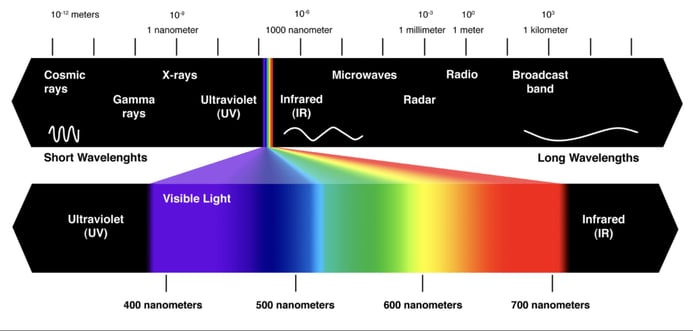
Posted on 02/03/2025 6:36:50 PM PST by Red Badger

There is something unique about the color purple: Our brain makes it up. So you might just call purple a pigment of our imagination.
It’s also a fascinating example of how the brain creates something beautiful when faced with a systems error.
To understand where purple comes from, we need to know how our eyes and brain work together to perceive color. And that all begins with light.
Light is another term for electromagnetic radiation. Most comes from the sun and travels to Earth in waves. There are many different types of light, which scientists group based on the lengths of those waves. (The wavelength is the distance between one wave peak and the next.) Together, all of those wavelengths make up the electromagnetic spectrum.
Our eyes can’t see most wavelengths, such as the microwaves used to cook food or the ultraviolet light that can burn our skin when we don’t wear sunscreen. We can directly see only a teeny, tiny sliver of the spectrum — just 0.0035 percent! This slice is known as the visible-light spectrum. It spans wavelengths between roughly 350 and 700 nanometers.
The acronym ROYGBIV (pronounced Roy-gee-biv) can be used to remember the order of colors in that visible spectrum: red, orange, yellow, green, blue, indigo and violet. You can see these colors in a rainbow stretching across the sky after a rainstorm or when light shines through a prism. In the visible spectrum, red light has the longest wavelength. Blue and violet are the shortest. Green and yellow sit toward the middle.
Although violet is in the visible spectrum, purple is not. Indeed, violet and purple are not the same color. They look similar, but the way our brain perceives them is very different.

How we see color
Color perception starts in our eyes. The backs of our eyes contain light-sensitive cells called cones. Most people have three types. They’re sometimes called red, green and blue cones because each is most sensitive to one of those colors.
But cones don’t “see” color, notes Zab Johnson. Instead, they detect certain wavelengths of light.
Johnson works at the University of Pennsylvania in Philadelphia. She and other scientists who study how we perceive color prefer to classify cones based on the range of wavelengths they detect: long, mid or short.
So-called red cones detect long wavelengths of light. Green cones respond most strongly to light in the middle of the visible spectrum. Blue cones best detect wavelengths toward the shorter end of the visible spectrum.
When light enters our eyes, the specific combination of cones it activates is like a code. Our brain deciphers that code and then translates it into a color.
Consider light that stimulates long- and mid-wavelength cones but few, if any, short-wavelength cones. Our brain interprets this as orange. When light triggers mostly short-wavelength cones, we see blue or violet. A combination of mid- and short-wavelength cones looks green. Any color within the visible rainbow can be created by a single wavelength of light stimulating a specific combination of cones.
:max_bytes(150000):strip_icc():format(webp)/the-visible-light-spectrum-2699036_FINAL2-c0b0ee6f82764efdb62a1af9b9525050.png)
Notice that the visible spectrum is a gradient. One color gradually shifts into the next. The activity of cones activated by the light also gradually shifts from one type to the next. At the red end of the spectrum, for instance, long-wavelength cones do most of the work. As you move from red to orange, the mid-wavelength cones help more and the long-wavelength cones do less.
In the middle of the rainbow — colors like green and yellow — the mid-wavelength cones are busiest, with help from both long- and short-wavelength cones. At the blue end of the spectrum, short-wavelength cones do most of the work.
But there is no color on the spectrum that’s created by combining long- and short-wavelength cones.
This makes purple a puzzle.
Purple is a mix of red (long) and blue (short) wavelengths. Seeing something that’s purple, such as eggplants or lilacs, stimulates both short- and long-wavelength cones. This confuses the brain. If long-wavelength cones are excited, the color should be red or near to that. If short-wavelength cones are excited, the color should be near to blue.
The problem: Those colors are on opposite ends of the spectrum. How can a color be close to both ends at once?
To cope, the brain improvises. It takes the visible spectrum — usually a straight line — and bends it into a circle. This puts blue and red next to each other.
“Blue and red should be on opposite ends of that linear scale,” Johnson explains. “Yet at some point, blue and red start to come together. And that coming-together point is called purple.”
Our brain now remodels the visible spectrum into a color wheel and pops in a palette of purples — which don’t exist — as a solution to why it’s receiving information from opposite ends of the visible spectrum.
Colors that are part of the visible spectrum are known as spectral colors. It only takes one wavelength of light for our brain to perceive shades of each color. Purple, however, is a nonspectral color. That means it’s made of two wavelengths of light (one long and one short).
This is the difference between violet and purple. Violet is a spectral color — part of the visible spectrum. Purple is a nonspectral color that the brain creates to make sense of confusing information.
Purple thus arises from a unique quirk of how we process light. And it’s a beautiful example of how our brains respond when faced with something out of the norm. But it’s not the only color that deserves our admiration, says Anya Hurlbert.
“All colors are made up by the brain. Full stop,” says this visual scientist at Newcastle University in England. They’re our brain’s way of interpreting signals from our eyes. And they add so much meaning to things we perceive, she says.
“The color of a bruise tells me how old it is. The color of a fruit tells me how ripe it is. The color of a piece of fabric tells me whether it’s been washed many times or it’s fresh off the factory line,” she says. “There’s almost nothing else that starts with something so simple [like a wavelength of light] and ends with something so deep and rich.”
Your reading comprehension is subpar. That sentence was followed but “YES?”. Ergo it was a statement with a question.
Have you ever tried lucid dreaming?
“And IF people who are colorblind have brains that aren’t broken/inferior/whatever, then WHY are they colorblind?”
Because they have defective cones and their brain never receives the full signals.
“Then WHY would different people see the same color differently, IF we are all seeing the same frequenci es and does it even matter?”
Just because the same frequencies are entering the eye doesn’t mean the same signals are sent to the brain,
“The spectrum chart is also off since it omits shades.”
The spectrum chart has all frequencies.
“Because I am color sensitive/shade sensitive ( meaning that I can easily tell the differences in tone and quality ), does that mean that my brain works better than most, or just differently? Or is it that this is because I have been painting most of my life?”
I don’t know. Their is a wide range of talents and learning.
And PLEASE do NOT argue with me about THAT! They either used the wrong color, or they are misusing the term "VIOLET". I'm extraordinarily good with color; names, shades, etc.! I have and have had many different brands of watercolors throughout my life and sometimes the same color, from two or more different manufacturers, are NOT exactly the same. And I know WHY, but that doesn't really matter re this discussion.
“And....a single pigment, though ONLY one color, gives off “many frequencies”? How so?”
Every substance gives off many frequencies. Every pigment gives off many frequencies.
That combination of frequencies becomes the “one color” in our brain.
Yep.... it’s a blast controlling various aspects of the dream especially “resetting” a “forced error”. It’s similar to a reset in a video game.
“Does a color that contains many different pigments give of MORE frequencies, even when it is in the same color family?”
As a painter I am sure you know that pigments are only “correct” when viewed with a standard light.
Red is gray, and yellow white. yet we decide which is real, and which is an illusion.
Moody Blues...................
Isn't "defective" the same as BROKEN?
Okay, I just looked it up and though a recessive gene, YES, colorblindness is inherited.
Both of my parents painted, both were excellent re color/shade matching, so maybe I did inherit the same ability and it wasn't a "learned" ability. I don't know, but that sounds correct.
“Yet their example of VIOLET is actually PURPLE!”
What example?
Ah, so close! You almost addressed what I asked you to in my comment #98.
I await the outcome.....
I’ve never been very disciplined at it - when I was very young, it happened automatically, and I would fly a lot. But I lost that as I grew older.
About a decade ago, I read Robert Waggoner’s book; I learned that if you just spend an hour or two attentively reading a good book about it, it may start to happen that very night; you’ve given yourself the suggestion.
(What’s been more interesting to me as I’ve grown older is that my dreams often productively carry on my waking thoughts and concerns, now. It’s like the 8 or so hours aren’t really wasted :-)
“And PLEASE do NOT argue with me about THAT! “
Maybe your monitor is off?
>It absolutely IS nonsense!
>The article is hogwash and even cointradicts itself.
You are absolutely correct about that. Firefox Deepfake Text detector said this article contains AI. Therefore it is BS
“Isn’t “defective” the same as BROKEN?”
Cones are in the eyes, not in the brain.
Similar to the way we detect temperature with our skin.
We have receptors for warm and cold but the sensation of hot is a result of BOTH of those being triggered at once.
The Ontario Science Center used to have a display demonstrating it. It’s pretty interesting.
And I'm NOT talking about a white or off white medium, but an entirely covered medium with some form of the same paint. If ONLY the paint exists, than the "frequencies" that said medium throws off, isn't at play at all.
LOL!!!
Depends on the ratios of the colors.
Disclaimer: Opinions posted on Free Republic are those of the individual posters and do not necessarily represent the opinion of Free Republic or its management. All materials posted herein are protected by copyright law and the exemption for fair use of copyrighted works.